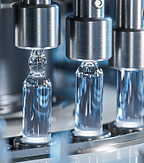Article | 17 May 2017
The European Commission’s nuanced approach in determining the market for pharmaceuticals in competition cases

The pharmaceutical sector is a dynamic industry experiencing rapid development and growth. Corporate transactions such as mergers, acquisitions and joint ventures are common. The European Commission (EC) and European competition authorities examine transactions that exceed certain turnover thresholds.(1) If the parties to such transactions have large market shares in a specific market, the transaction, or part of the transaction, is liable to significantly impede the existence or development of effective competition and may thus be declared not to be compatible with competition legislation.
The first step in the competitive assessment is to define the relevant geographic and product market for the products included in the transaction. The relevant geographic market for pharmaceuticals is, by default, national in scope, due to the different national regulatory frameworks as regards price and reimbursement.
In the pharmaceutical sector, the general approach to product market definition has been based on the Anatomical Therapeutic Chemical Classification System of WHO (commonly known as ATC). The ATC classification divides pharmaceuticals into different categories depending on factors such as anatomical sites of action, therapeutic use and chemical properties. The first level (ATC1) is the least detailed, and each category at this level is decided by the pharmaceutical’s target organ. The fourth level (ATC4) is the most detailed and divides products into different groups based on their molecules. Traditionally, the EC has usually maintained an “ATC3 approach” in merger filing assessments. This means that the relevant market is defined according to the product’s therapeutic indications, i.e. the drug action that will deal with the disease in question. In some cases the EC also carries out analyses at other ATC levels, or mixtures thereof, if the circumstances of a case show that the ATC3 class does not lead to a correct market definition. For example, when it comes to generic drug company mergers, ATC4 has often been used as a starting point for the EC’s analysis.
Recent case law indicates that the EC is moving away from this ATC approach in favour of a more nuanced approach in its competitive assessment. We are not just thinking about treating prescription medicines and OTC medicines as two separate markets or dividing the market on the basis of different galenic forms (i.e. dosage, pharmaceutical form and route of administration). In some cases, such as the Sanofi-Aventis/Genzyme case, the EC has even stressed that the ATC3 and ATC4 categories were not relevant for market definition of some products owing to the clear difference in indications between certain products classified in these categories.
The EC is also defining the market to an ever greater extent by reference to therapeutic use, while increasingly looking at pipeline products, i.e. products under development that are not yet on the market. In a merger between two companies with pipeline products, the EC will also consider whether the pipeline products may have an impact on competition. In the Sanofi-Aventis/Genzyme case the EC considered, as part of its full competitive analysis, that both parties involved had pipeline products in Phase III of clinical trials (the final stage of development before the company can apply for market authorization) which it took into consideration in its competition assessment. In another pharma merger case, the Novartis/GSK Oncology case, the EC went further and considered information concerning Phase I and Phase II clinical projects. The EC adopted a protective position for innovation and considered that the merger would impede trials that were at an earlier stage, noting that it was likely that Novartis would abandon its broad clinical programme for certain types of cancer if the merger was completed. In the Novartis/GlaxoSmithKline Oncology case, the EC also raised the point that national registration and national reimbursement rules for oncology drugs, which strongly influence prescribing behaviour, may have to be taken into consideration when deciding whether a distinction should be made according to lines of treatment, and the EC considered the possibility of defining the market based on the type and stage of cancer.
The EC has also considered the biopharmaceutical market in several merger cases. In some cases, biopharmaceuticals and small molecules/chemical substances have been considered as different markets. In addition, biosimilars (a kind of generic version of a biopharmaceutical, although not an exact copy of the originator product) have been considered a separate product market from the originator drug due, for example, to the fact that the development of a biosimilar takes six to eight years from development to marketing, and involves higher investments than generics. However, in the Pfizer/Hospira case, the EC noted that biological drugs are some of the most expensive therapies available. Therefore, introduction of biosimilars to the market is expected to allow wider access by patients to biological drugs. Taking into account that earlier biosimilars have led to price decreases compared to the originators’ biological drugs, expectations are that biosimilars will relieve financial pressure on healthcare systems. In this case, the EC found that the originator biological product and the biosimilar be-longed to the same relevant product market.
It may be worth noting that the EC does not adhere to a mechanical ATC3 approach but instead uses different approaches to identify relevant product markets. The competition analysis has become more complex as the EC has attached greater importance to the specific features of the pharmaceutical industry, for example different regulatory frameworks and innovation. The EC has, in several cases, protected innovation and considered it to be of significant importance for the pharmaceutical sector. This approach is noticeable when the assessment considers potential competition from pipeline products (these products generally have a 50 percent trial success rate in Phase III and an even lower success rate in Phase I and Phase II). In view of this approach, it cannot be ruled out that a greater number of companies will have their products found to be on a different market than the market determined on the basis of ATC3. The pharmaceutical companies must thus carry out a more complex competition analysis as regards their product portfolios before taking steps towards a transaction.
(1) A transaction must be notified to the Swedish Competition Authority if the parties’ combined aggregate turnover in Sweden in the preceding financial year exceeds SEK 1 billion, and two parties have turnover in Sweden in the preceding financial year exceeding SEK 200 million each. If the parties’ combined aggregate worldwide turnover in the preceding financial year exceeds EUR 2.5 billion, the parties must verify whether the transaction has to be notified to the EC instead.


